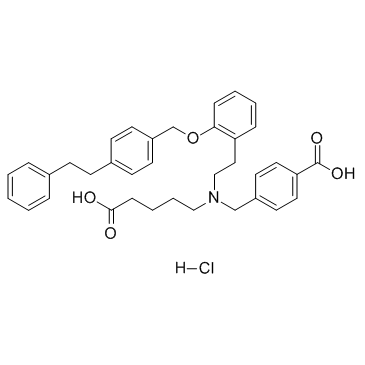| Description |
Cinaciguat hydrochloride is a potent soluble guanylate cyclase (GC) activator with EC50 of 15 nM in platelets.
|
| Related Catalog |
|
| Target |
EC50:15 nM (Guanylate cyclase)[1]
|
| In Vitro |
In platelets, Cinaciguat (BAY 58-2667) is a potent GC activator (EC50 15 nM) but the maximum effect is only about 1% of that achievable with NO. Concentration-response curves for Cinaciguat are constructed after 1 min exposure in the presence of sildenafil. Without ODQ, the EC50 is 18 nM, and in the presence of ODQ the potency of Cinaciguat is not significantly different, the EC50 being 13 nM. The potency of Cinaciguat in platelets (EC50 15 nM) is very similar to estimates made on purified recombinant GC. Cinaciguat at a maximally effective concentration of 1 μM stimulates control GC activity to about 25% of that observed with NO and, contrasting with the stimulation by NO, this level of activity remained constant as the proportion of ODQ-pretreated GC is increased[1].
|
| In Vivo |
Administration of Cinaciguat decreased BP and increased HR in both apo-sGC mice and WT mice. In fact, the BP-lowering effect of Cinaciguat in apo-sGC mice is significantly greater and longer lasting than in WT mice. In addition, Cinaciguat decreased BP in apo-sGC mice at concentrations that did not affect BP in WT mice. Furthermore, the IC50 values for Cinaciguat-induced ex vivorelaxation of precontracted aortas are threefold lower in apo-sGC mice than in WT mice (IC50=0.2 nM and 0.7 nM, respectively). Together, our results suggest that sGC activators like Cinaciguat but not sGC stimulators like BAY 41-2272 activate apo-sGC. In addition, the observation that Cinaciguat can modulate vasorelaxation and BP in WT mice suggests that even in healthy mice, a subset of the available sGC pool is haem-free and responsive to sGC activators[2].
|
| Kinase Assay |
Aliquots of the platelet suspension are withdrawn before and at various times after addition of spermine NONOate or Cinaciguat and transferred immediately into inactivation buffer (50 mM Tris, 4 mM EDTA, pH 7.4) at 100°C for at least 10 min. When used, 10 μM ODQ is added to the platelets 15 min before addition of spermine NONOate. Purified GC activity is measured at a final concentration of 50 ng/mL in assay buffer (50 mM Tris, 100 μM EDTA, 1 mM NaGTP, 1.3 mM MgCl2, 50 μg/mL BSA, pH 7.4), stimulated with DEA/NO (10 μM) or Cinaciguat (1 μM), enzyme inactivation being performed as with platelets. The levels of cGMP are measured by radioimmunoassay and expressed relative to the amount of protein. Three independent runs are carried out in each experiment and the resulting data presented as means±s.e.mean[1].
|
| Animal Admin |
Mice[2] Male and female mice (12 weeks old) are anaesthetized with isoflurane, 0.5 cm of the tail tip is removed with a sharp razor blade, and the tail tip is immediately put into fresh pre-warmed PBS of 37°C. The latency until the tail stopped bleeding is visually scored and recorded with a chronometer by an observer blinded to the genotype. Systolic BP (SBP) and heart rate (HR) are measured non-invasively in awake mice by tail-cuff using a Hatteras MC4000 Blood Pressure Analysis System. Mice are habituated to the BP measurement device for 7 days. To determine basal BP, mice are measured for 15 consecutive cycles per day during 5 days. L-NAME (100 mg/kg), SNP (1.5 mg/kg), DETA-NO (60 mg/kg), BAY 41-2772 (4 mg/kg), Cinaciguat (30 μg/kg) and the vehicle controls (PBS or for the BAY-compounds 20% Cremophor+20% diethylene-glycol-monoethyl-ether in PBS) are all administered IP. After SNP administration, SBP measurements are recorded from 5 to 15 min post injection, for L-NAME and DETA-NO recordings are made from 1 to 25 min post injection and for BAY-compounds recordings are made from 10 to 25 min post injection.
|
| References |
[1]. Roy B, et al. Probing the presence of the ligand-binding haem in cellular nitric oxide receptors. Br J Pharmacol. 2008 Apr;153(7):1495-504. [2]. Thoonen R, et al. Cardiovascular and pharmacological implications of haem-deficient NO-unresponsive soluble guanylate cyclase knock-in mice. Nat Commun. 2015 Oct 7;6:8482.
|
